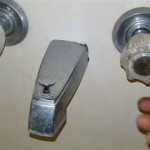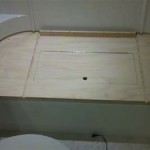Is It Hard To Replace A Bathtub Faucet?
Replacing a bathtub faucet might seem like a daunting task to some homeowners, while others consider it a manageable DIY project. The difficulty level largely depends on several factors including plumbing experience, the type of faucet being replaced, and the condition of the existing plumbing. Understanding these factors and the steps involved can help determine whether this is a project you can tackle yourself or if professional assistance is required.
The decision to replace a bathtub faucet often stems from a desire to update the bathroom's aesthetics, address a leaky faucet, or improve water flow. Whatever the reason, a systematic approach and a clear understanding of the process are essential for a successful replacement. Ignoring potential complications or lacking the necessary skills could lead to further plumbing problems and increased expenses. Therefore, a thorough evaluation of your capabilities and the complexity of the job is crucial before commencing the project.
Before considering any replacement, it is necessary to identify the appropriate type of faucet. Bathtub faucets come in various styles, each requiring different installation methods. These include wall-mounted faucets, deck-mounted faucets, and freestanding faucets. Wall-mounted faucets are installed directly into the wall, often requiring access behind the wall for pipe connections. Deck-mounted faucets are installed on the bathtub's rim or surrounding deck, typically involving flexible supply lines. Freestanding faucets are installed independently of the bathtub, often used with freestanding tubs and requiring specialized plumbing considerations.
Replacing a bathtub faucet involves several key steps, each demanding attention to detail. These steps generally include shutting off the water supply, removing the old faucet, preparing the area for the new faucet, installing the new faucet, and testing for leaks. Skipping any of these steps or performing them incorrectly can result in water damage or necessitate further repairs.
Assessing Your Plumbing Skills and Experience
The first step in determining the difficulty of replacing a bathtub faucet is honestly assessing your own plumbing skills and experience. Have you previously undertaken similar plumbing projects, such as replacing a sink faucet or repairing a leaky pipe? Familiarity with basic plumbing tools and techniques is essential. These tools often include pipe wrenches, adjustable wrenches, screwdrivers, pliers, Teflon tape, and a basin wrench. Furthermore, understanding how to properly shut off the water supply and connect pipes without causing leaks is crucial.
If you have limited or no plumbing experience, attempting to replace a bathtub faucet without proper preparation could lead to frustration and potential damage. It is advisable to start with smaller plumbing projects to gain experience before tackling more complex tasks. Alternatively, consulting online resources, watching instructional videos, or taking a basic plumbing course can provide valuable knowledge and skills.
For instance, if the existing plumbing is old or corroded, removing the old faucet might require more force and could potentially damage the surrounding pipes. Knowing how to handle such situations without causing further damage requires experience and the right tools. Similarly, connecting the new faucet requires ensuring a watertight seal, which often involves using Teflon tape or pipe joint compound correctly. Improper sealing can lead to leaks, which can cause water damage and necessitate costly repairs.
Identifying Potential Complications and Challenges
Beyond your own skills, the complexity of the existing plumbing system and the condition of the pipes play a significant role in the difficulty of replacing a bathtub faucet. Older homes often have outdated plumbing systems with corroded pipes and difficult-to-access connections. Removing an old faucet from corroded pipes can be challenging, as the connections may be rusted and difficult to loosen. Applying excessive force could damage the pipes or even cause them to break, leading to more extensive repairs.
Another potential complication is the presence of mineral buildup around the faucet connections. Over time, mineral deposits can accumulate, making it difficult to remove the old faucet and connect the new one. Special tools and techniques might be required to remove the mineral buildup without damaging the pipes. In some cases, it might be necessary to replace sections of the old pipes to ensure a proper connection.
Furthermore, access to the plumbing connections can be a challenge in some bathrooms. Depending on the location of the bathtub and the layout of the bathroom, it might be difficult to reach the pipes behind the wall or under the tub. Limited access can make it difficult to use tools and perform the necessary steps for replacing the faucet. In such cases, it might be necessary to remove sections of the wall or floor to gain better access to the plumbing connections.
Understanding the Steps Involved in Faucet Replacement
The faucet replacement process, while seemingly straightforward, involves several steps that demand careful attention. The first step is to shut off the water supply to the bathtub. This usually involves locating the shut-off valves for the hot and cold water lines leading to the faucet. If these valves are not readily accessible or are not functioning properly, it might be necessary to shut off the main water supply to the entire house. Failing to properly shut off the water supply can result in flooding and water damage.
Next, the old faucet needs to be removed. This typically involves disconnecting the supply lines and unscrewing any mounting hardware. Depending on the type of faucet and the condition of the pipes, this step can be relatively easy or quite challenging. As previously mentioned, corroded pipes or mineral buildup can make it difficult to loosen the connections. It's crucial to exercise caution and avoid applying excessive force that could damage the pipes.
Once the old faucet is removed, the area needs to be prepared for the new faucet. This might involve cleaning the mounting surface, removing any old sealant or putty, and ensuring that the supply lines are properly aligned. It's important to make sure the new faucet will fit properly and that the connections are clean and free of debris. Any imperfections in the mounting surface or misaligned supply lines can lead to leaks or difficulty in securing the new faucet.
Installing the new faucet involves connecting the supply lines and securing the faucet to the tub or wall. Proper sealing is crucial to prevent leaks. Teflon tape or pipe joint compound should be applied to the threaded connections to create a watertight seal. The supply lines should be tightened securely, but not overtightened, as this can damage the connections. Once the faucet is installed, the water supply should be turned back on gradually, and the faucet should be tested for leaks. Any leaks should be addressed immediately by tightening the connections or reapplying sealant.
Ultimately, the decision to replace a bathtub faucet yourself depends on a combination of your plumbing skills, the complexity of the installation, and your comfort level. A thorough assessment of these factors will help you determine whether you can confidently tackle the project or if seeking professional assistance is the more prudent choice.

How To Fix A Leaking Bathtub Faucet Diy Family Handyman

How To Change A Bathtub Faucet 14 Steps With Pictures Wikihow

Plumbing How To Replace A Jacuzzi Bathtub Faucet Home Improvement Stack Exchange

How To Replace A Bathtub Faucet

How To Replace A Mobile Home Bathtub Faucet

Bathtub Spout With Diverter Replacement Fix Leaking Tub Jonny Diy

Replacing A Tub Faucet Bathtub Spout Replacement

How To Change A Bathtub Faucet 14 Steps With Pictures Wikihow

How To Replace A Bathtub Faucet Beginner S Guide

How To Fix A Leaking Bathtub Faucet The Home Depot








